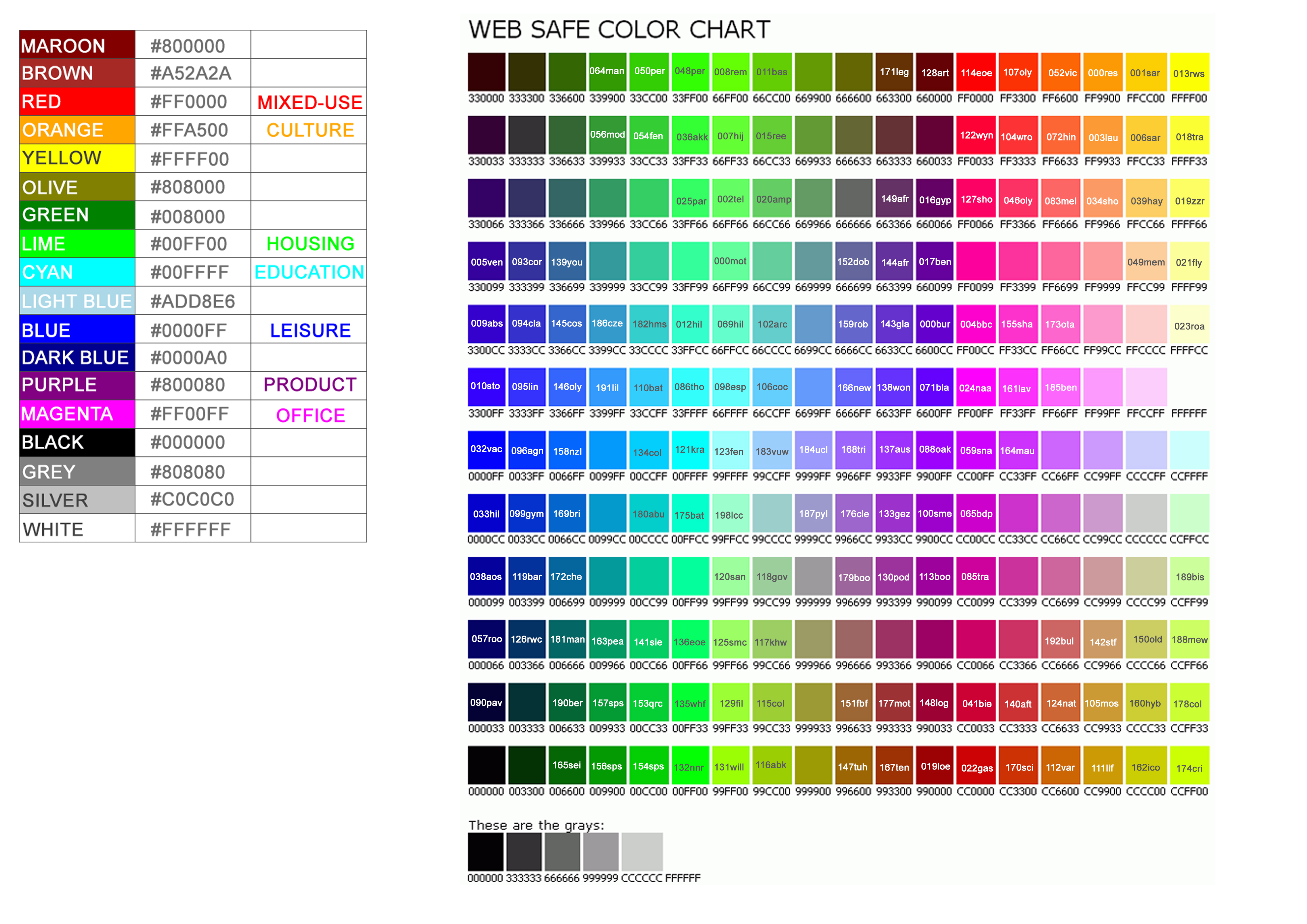000off_DEPART/Y
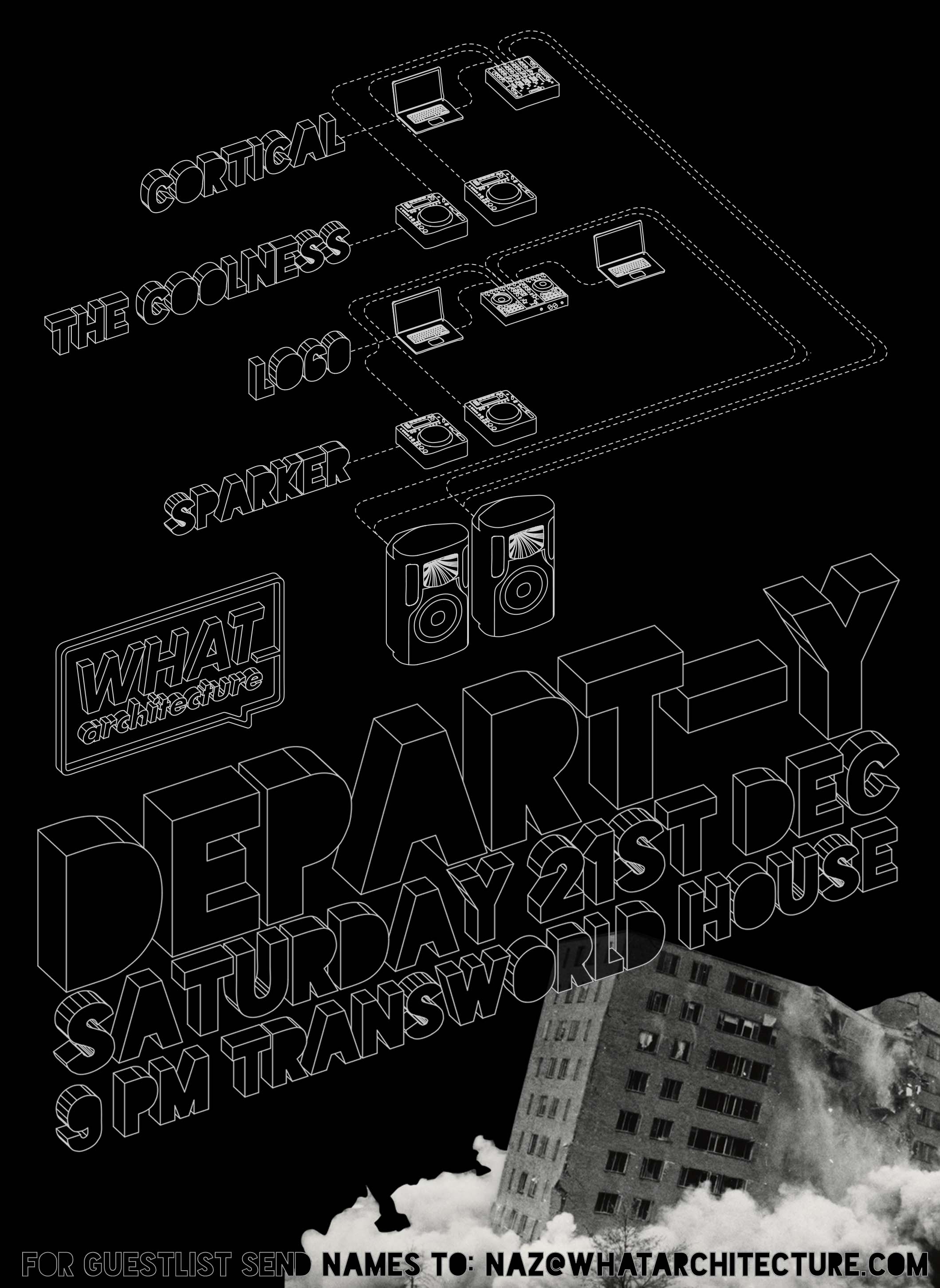
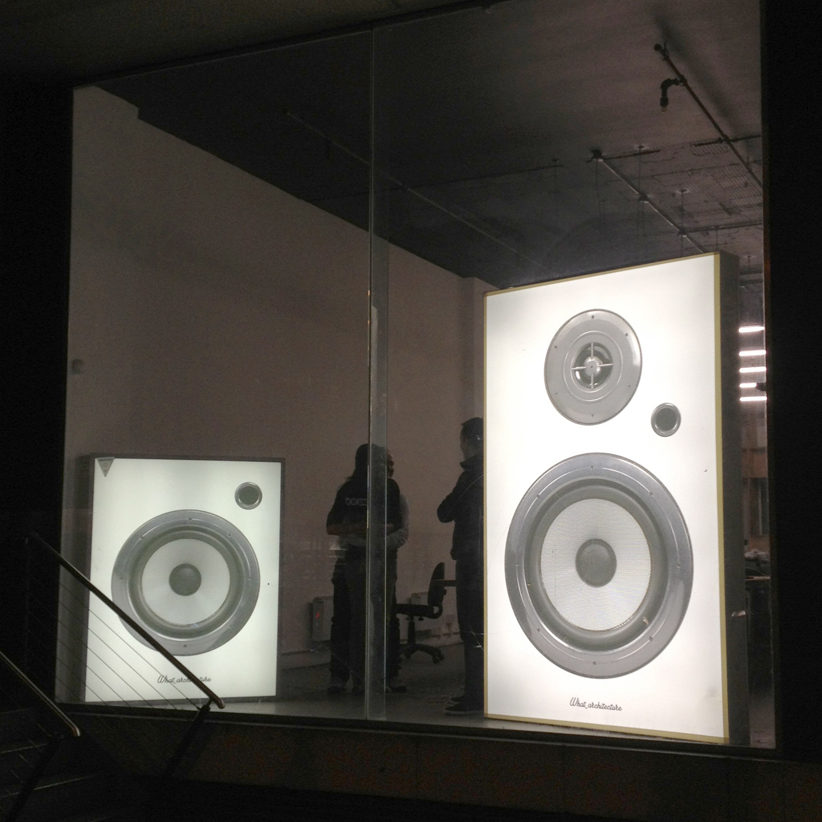 DEPART+PARTY=DEPART/Y
Contact: naz@whatarchitecture.com for details, guest list requests. No door sales.
DEPART+PARTY=DEPART/Y
Contact: naz@whatarchitecture.com for details, guest list requests. No door sales.
179prs_3 SIDED FOOTBALL
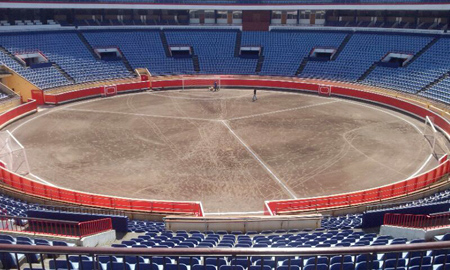 Three sided football was devised in 1962 by the Danish artist Asger Jorn, and this version of the beautiful game is an extension of his links to the Marxist-inspired Situationist movement. Jorn saw traditional football as a representation of the “us versus them” class struggle of the time and wanted to create an alternative which reflected the complexity of society and encouraged cooperation. In this game, three, not two, teams would strive on a hexagonal pitch, collaborating rather than competing, agreeing amongst themselves what was allowable and not allowable, rather than being controlled by an outside force. In other words: no rules, no refs.
It is little surprise, then, that the bulk of those drawn to the sport are left-leaning, although Geoff Andrews, from Philosophy Football FC, believes its popularity is also linked to a growing disillusionment with modern football. “There’s an emphasis on teamwork [in three-sided football] but it’s also about individual expression, and at a time when there is a worry about the commodification and corporatisation of football this brings back the true essence of the sport,” he said. Two decades on from the first-known organised three-sided match, there remain no rules beyond a handful of basic principles: the pitch must be hexagonal in shape and equally divided into three, halves can last for any length of time, teams can vary in size, there are no offsides, and goalkicks, throw-ins and corners operate on the basis of each team having two sides on the pitch: if the ball goes out on either of your sides you get the set piece; if it went out off you, it goes to the team whose goal is nearest to the ball. The key principle is that the team who concedes the fewest goals wins, with goals scored only counting in the event of a tie, and it is this which leads not only to the cooperative nature of three-sided football but also to what Dyson described as its “element of bluff”. Gazzetta dello Sport’s Filippo Ricci calls it “organised confusion”.
In 2010, Sally O’Reilly, then writer in residence at Whitechapel Gallery in east London, organised a match in which three teams would represent the main political parties in a game designed to demonstrate the shifting allegiences and balance of power in party politics. Philosophy Football FC formulated a set of rules which could be used in a real situation.
1. Scoring
A team does not count the goals it scores, only the goals it concedes. The winner is the team that concedes the fewest goals.
2. Throw-ins / goal-kicks / corners
On the hexagonal pitch, each team has two sides of the six-sided pitch: the side with the goal (the ‘backside’) and the side opposite to your goal (the ‘frontside’). If the ball goes out on one of your two sides, you get the throw-in / goal-kick. If it went out off you, the throw-in or corner goes to the team whose own goal is nearest to where the ball went out.
3. Referees
While there is a temptation to have no referees with the following dictat in mind: ‘The game deconstructs the mythic bi-polar structure of conventional football, where an us-and-them struggle mediated by the referee mimics the way the media and the state pose themselves as “neutral” elements in the class struggle’, the match will have two referees, able to make discerning philosophical judgements.
4. Duration of match
Ideally, teams will play until people get bored, start to wander off, fall asleep etc: however, three thirty-minute ‘halves’ with teams rotating goals would work well.
5. Other rules
There will be no off-sides. There will be rolling subs, rush goalies etc.
Three sided football was devised in 1962 by the Danish artist Asger Jorn, and this version of the beautiful game is an extension of his links to the Marxist-inspired Situationist movement. Jorn saw traditional football as a representation of the “us versus them” class struggle of the time and wanted to create an alternative which reflected the complexity of society and encouraged cooperation. In this game, three, not two, teams would strive on a hexagonal pitch, collaborating rather than competing, agreeing amongst themselves what was allowable and not allowable, rather than being controlled by an outside force. In other words: no rules, no refs.
It is little surprise, then, that the bulk of those drawn to the sport are left-leaning, although Geoff Andrews, from Philosophy Football FC, believes its popularity is also linked to a growing disillusionment with modern football. “There’s an emphasis on teamwork [in three-sided football] but it’s also about individual expression, and at a time when there is a worry about the commodification and corporatisation of football this brings back the true essence of the sport,” he said. Two decades on from the first-known organised three-sided match, there remain no rules beyond a handful of basic principles: the pitch must be hexagonal in shape and equally divided into three, halves can last for any length of time, teams can vary in size, there are no offsides, and goalkicks, throw-ins and corners operate on the basis of each team having two sides on the pitch: if the ball goes out on either of your sides you get the set piece; if it went out off you, it goes to the team whose goal is nearest to the ball. The key principle is that the team who concedes the fewest goals wins, with goals scored only counting in the event of a tie, and it is this which leads not only to the cooperative nature of three-sided football but also to what Dyson described as its “element of bluff”. Gazzetta dello Sport’s Filippo Ricci calls it “organised confusion”.
In 2010, Sally O’Reilly, then writer in residence at Whitechapel Gallery in east London, organised a match in which three teams would represent the main political parties in a game designed to demonstrate the shifting allegiences and balance of power in party politics. Philosophy Football FC formulated a set of rules which could be used in a real situation.
1. Scoring
A team does not count the goals it scores, only the goals it concedes. The winner is the team that concedes the fewest goals.
2. Throw-ins / goal-kicks / corners
On the hexagonal pitch, each team has two sides of the six-sided pitch: the side with the goal (the ‘backside’) and the side opposite to your goal (the ‘frontside’). If the ball goes out on one of your two sides, you get the throw-in / goal-kick. If it went out off you, the throw-in or corner goes to the team whose own goal is nearest to where the ball went out.
3. Referees
While there is a temptation to have no referees with the following dictat in mind: ‘The game deconstructs the mythic bi-polar structure of conventional football, where an us-and-them struggle mediated by the referee mimics the way the media and the state pose themselves as “neutral” elements in the class struggle’, the match will have two referees, able to make discerning philosophical judgements.
4. Duration of match
Ideally, teams will play until people get bored, start to wander off, fall asleep etc: however, three thirty-minute ‘halves’ with teams rotating goals would work well.
5. Other rules
There will be no off-sides. There will be rolling subs, rush goalies etc.
000off_LONDINIUM ROMAN WALL
If you walk from our Shoreditch office down Bishopsgate you will find yourself in Londinium, Roman London. The line of Bishopsgate St follows that of Ermine St which was the major Roman road north from London Bridge. Tombs once lined the path as it approached the City, just as they did along the Appian Way in Rome. The essential plan of the City of London was laid out by the Romans when they built their wall around Londinium at the end of the second century, after Boudica and her tribes burnt the settlement. Eighty years earlier, the Romans had constructed a fort where the Barbican stands today and, in their defensive plan, they extended its walls south to the Thames and in an easterly arc that met the river where the Tower of London stands now.
Yet, in the mile between Bishopsgate and the Barbican, very little has survived from the centuries in which stone from the Londinium wall was pillaged for other buildings. It is possible to seek access to some corporate premises with lone fragments marooned in the basement. Or if you visit the London Wall Underground Car Park in EC2 you will bizarrely find a section of Roman Wall lodged in parking place 52. Furthermore this fragment of the wall will alleged be integrated into a private member’s club, The Shower Club… a modern variant on the Roman Baths no doubt.





179prs_GAME OF ARCHITECTURE
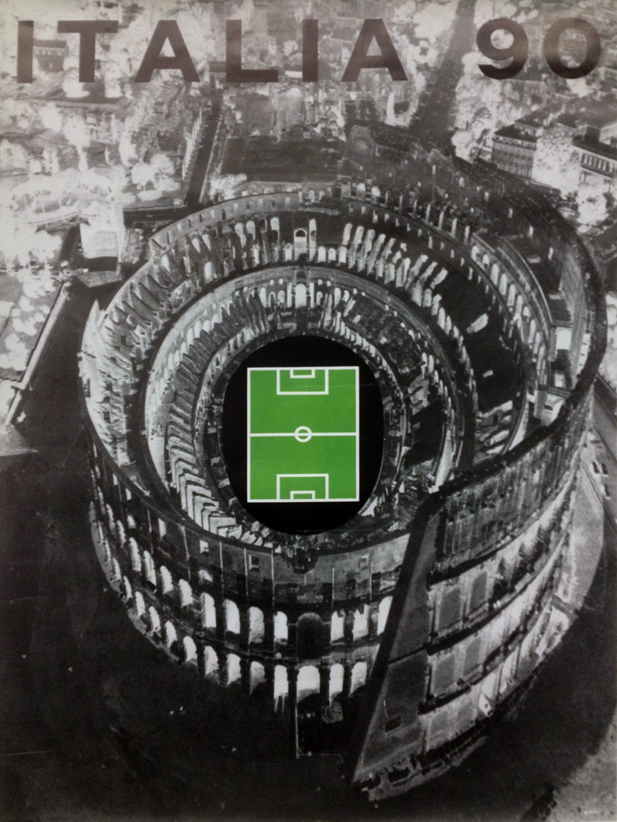 (Christies Lot 70, Sale 5483, Alberto Burri (1915-1995) Italia 90 offset lithograph in colours, 1990 Estimate: £500-700, by famous Italian mixed-media artist Alberto Burri (1915-1995) for the 1990 World Cup: Italia 90 is one of six versions produced for the 1990 World Cup, each with a different coloured central football pitch placed inside the contrasting black and white colosseum.)
Game play underpins the activities of WHAT_architecture. Let’s play a game noting that practise makes perfect!
When ‘practice’ (noun) is applied to architecture it suggests ideas of space: work place, office, institution, ethos.
When ‘practise’ (verb) is applied to architecture it suggests ideas of event: repetition, action. If applied to practising architecture, then this proposes that the result will be manifest in something. But what exactly? Is it in building(s) as architects so desperately pursue (even Philip Johnson said architects will design for nothing to get something built). If building was the goal of architecture, our office would then have to refute the ‘paper architecture’ of our founding thesis which researched John Hejduk’s Ten Texan Houses (all unbuilt). The legitimate contemporary expression of architecture is hardly building – Beatriz Colomina has long since opined that the book not the building is the legimate expression of architecture. We understood buildings through books, magazines and so ‘No’ architecture is not building and yet architecture has moved beyond print. So further than the big books (SMLXL and ‘Yes Is More’) to ‘Yes’: Yesterday’s paper architecture is today’s ‘screen architecture’. DeZeen, ArchDaily, Coolhunter are our pages: in digital, on the web, highly accessible and therefore more difficult to find Google withstanding.
Every contract drawing that WHAT_architecture issues features in its title block the rallying call of ‘Life Beyond Buildings’. What does this mean? We have spent a lot of time in the education sector – a nursery begats a school begats a university begats a city. Yet for the architect, SMLXL is not only about scale, but also about career progression. My time in education has a somewhat paradoxical conclusion: by studying in a school, teaching at a school and ultimately designing and building schools I have begrudgingly realised you ‘can teach under a tree’.
Learning is not about space, it is about people. The design of schools ought to be about the subjugation of space to the facilitation of events. Hence Life Without Buildings!
WHAT_architecture likes to ‘play with architecture’ . In doing so we aim to put the fun-back-into functionalism. To enjoy work. The Game of Architecture is played out everyday in the machinations of the press, the egomania of the architect, the contrivedness of predetermined competitions, in the awariding out of seasonal prizes. Yet the casting of architecture as a game to be played can also be strategic, tactical and ultimately rewarding for both player, spectator and society.
(Christies Lot 70, Sale 5483, Alberto Burri (1915-1995) Italia 90 offset lithograph in colours, 1990 Estimate: £500-700, by famous Italian mixed-media artist Alberto Burri (1915-1995) for the 1990 World Cup: Italia 90 is one of six versions produced for the 1990 World Cup, each with a different coloured central football pitch placed inside the contrasting black and white colosseum.)
Game play underpins the activities of WHAT_architecture. Let’s play a game noting that practise makes perfect!
When ‘practice’ (noun) is applied to architecture it suggests ideas of space: work place, office, institution, ethos.
When ‘practise’ (verb) is applied to architecture it suggests ideas of event: repetition, action. If applied to practising architecture, then this proposes that the result will be manifest in something. But what exactly? Is it in building(s) as architects so desperately pursue (even Philip Johnson said architects will design for nothing to get something built). If building was the goal of architecture, our office would then have to refute the ‘paper architecture’ of our founding thesis which researched John Hejduk’s Ten Texan Houses (all unbuilt). The legitimate contemporary expression of architecture is hardly building – Beatriz Colomina has long since opined that the book not the building is the legimate expression of architecture. We understood buildings through books, magazines and so ‘No’ architecture is not building and yet architecture has moved beyond print. So further than the big books (SMLXL and ‘Yes Is More’) to ‘Yes’: Yesterday’s paper architecture is today’s ‘screen architecture’. DeZeen, ArchDaily, Coolhunter are our pages: in digital, on the web, highly accessible and therefore more difficult to find Google withstanding.
Every contract drawing that WHAT_architecture issues features in its title block the rallying call of ‘Life Beyond Buildings’. What does this mean? We have spent a lot of time in the education sector – a nursery begats a school begats a university begats a city. Yet for the architect, SMLXL is not only about scale, but also about career progression. My time in education has a somewhat paradoxical conclusion: by studying in a school, teaching at a school and ultimately designing and building schools I have begrudgingly realised you ‘can teach under a tree’.
Learning is not about space, it is about people. The design of schools ought to be about the subjugation of space to the facilitation of events. Hence Life Without Buildings!
WHAT_architecture likes to ‘play with architecture’ . In doing so we aim to put the fun-back-into functionalism. To enjoy work. The Game of Architecture is played out everyday in the machinations of the press, the egomania of the architect, the contrivedness of predetermined competitions, in the awariding out of seasonal prizes. Yet the casting of architecture as a game to be played can also be strategic, tactical and ultimately rewarding for both player, spectator and society.
000off_PHILIP JOHNSON TALKING BUILDING!
The greatest architecture you can make won’t be because you are the greatest architect but because you are the greatest client you will ever have… “there’s only one good client and that is yourself”. “The Parthenon doesn’t haven’t an exterior…. skyscrapers don’t have interiors!” And in response to modern office fluorescent lighting was Johnson’s work station desk lamps: “Homeliness… in the office.” “We don’t tear up our work: we build it.” “Architects are the employers of developers.” “We would do it for nothing if we can eat.”

000off_BRUTALISM AT HOME
Denys Lasdun’s brutalist concrete legacy posthumously endorsed by way of soft home furnishing aprons, pillow cases…





218coa_INFOGRAPHIC CITY
Which Reminds Me… features a day in the life of a woman working in London’s Square Mile solely through infographics; this includes labelled close-ups of everyday objects, product lifecycles, schematic diagrams, charts, and is generally illustrated in a simple isometric visual style.

000off_Google
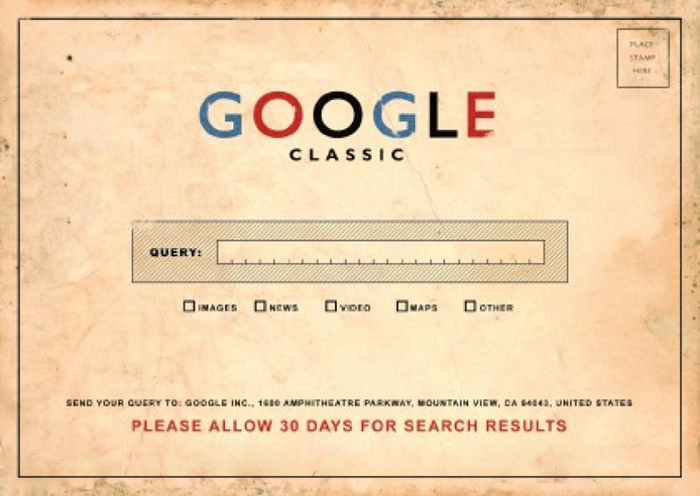 Google as Librarian from back in the day when researching meant a visit to a building… from Boomerang NL
Google as Librarian from back in the day when researching meant a visit to a building… from Boomerang NL
